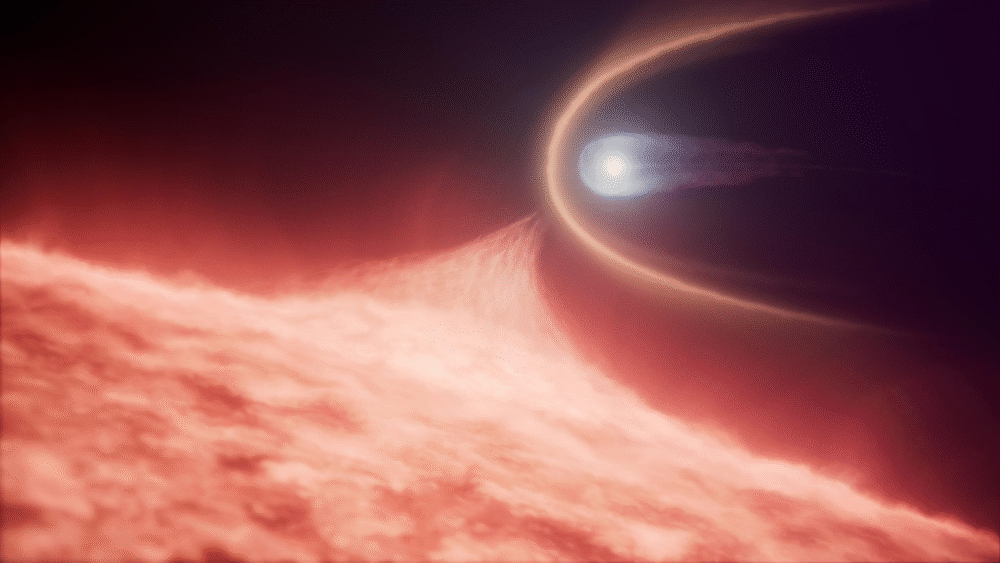Astronomers Discover a Rare “Zombie Star” Born From a Stellar Collision

Astronomers using NASA’s Hubble Space Telescope have identified an extraordinary white dwarf star that carries the marks of a violent past. Instead of being the quiet remnant of a single star, this ultra-massive white dwarf, named WD 0525+526, was formed through a stellar merger. This makes it one of the rarest types of white dwarfs ever studied, and its properties provide valuable insights into how stars can evolve in unusual ways.
What Exactly Was Found
WD 0525+526 is located around 128–130 light-years away, in the constellation Auriga. This star is about 20% more massive than the Sun, with a mass of 1.2 solar masses—making it an ultra-massive white dwarf. Its surface is blisteringly hot at about 21,000 kelvins (roughly 37,000 degrees Fahrenheit), which sets it apart even from other known merger remnants.
In visible light, WD 0525+526 looks like a normal white dwarf. But when astronomers used Hubble’s Cosmic Origins Spectrograph (COS) to observe it in ultraviolet (UV) light, the true story was revealed. Its spectrum showed traces of carbon in the atmosphere—something that would normally remain hidden under thick hydrogen and helium layers in typical single-star white dwarfs.

Credit: NASA, ESA, STScI, Ralf Crawford (STScI)
Why Carbon Matters
In a standard white dwarf created from a single star, the atmosphere is mostly hydrogen and helium, while the core is composed of heavier elements such as carbon and oxygen. Normally, those core elements remain buried and invisible. Detecting carbon in the atmosphere indicates that the star’s hydrogen and helium layers are far thinner than usual.
For WD 0525+526, the outer layers of hydrogen and helium are about 10 billion times thinner than those in a typical white dwarf. This stripping effect points directly to a stellar collision—a white dwarf merging with another star, possibly a companion subgiant or another white dwarf. During such a violent process, much of the hydrogen and helium is burned away or ejected, exposing traces of the carbon interior.
The Puzzling Carbon Levels
What makes WD 0525+526 even more unusual is the tiny amount of carbon found in its atmosphere. The carbon levels are about 100,000 times lower than in other known white dwarf merger remnants. In precise terms, the abundance is measured at log(C/H) ≈ –4.62, far lower than what has been documented in previous cases.
This poses an interesting puzzle. Cooler white dwarfs can use convection to mix carbon into their atmospheres, but WD 0525+526 is too hot for that. Instead, astronomers determined that a gentler process called semi-convection is responsible. This process brings small amounts of carbon upward into the thin hydrogen-helium atmosphere. In fact, this is the first detection of semi-convection in a white dwarf.
Why Only Hubble Could See It
Detecting this faint signature of carbon would have been impossible without Hubble’s UV capabilities. At visible wavelengths, spectral lines of elements heavier than helium become too faint in hotter white dwarfs. But in the ultraviolet, those signals remain strong enough for Hubble’s sensitive spectrograph to pick up.
Without ultraviolet observations, WD 0525+526 would have appeared to be just another normal white dwarf. This highlights how many other seemingly ordinary white dwarfs may actually be merger remnants hiding in plain sight.
Broader Implications
This discovery, published in Nature Astronomy on August 5, 2025, marks the first time a white dwarf formed through a merger has been identified by UV carbon detection. Prior to this, only six other merger products were known, all revealed by their visible-light carbon signatures. WD 0525+526 is hotter, more massive, and chemically different than those earlier cases.
Because the carbon layer is so thin and the hydrogen-helium layers are so stripped, WD 0525+526 is believed to be at a very early stage of its post-merger life. This makes it a unique opportunity to study how these stars evolve. Astronomers suspect that more stars like this exist but can only be uncovered with detailed ultraviolet studies.
The findings also connect to bigger questions in astrophysics: how often stars merge, how these mergers contribute to the population of white dwarfs, and whether such systems can eventually lead to supernova explosions. Each newly discovered merger remnant helps refine our understanding of stellar evolution and binary interactions.
TLDR
Astronomers discovered WD 0525+526, a 1.2 solar-mass white dwarf formed from a stellar merger, located 130 light-years away. Ultraviolet data from Hubble revealed extremely thin hydrogen-helium layers and tiny carbon traces, showing semi-convection and highlighting many hidden merger remnants.





